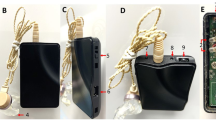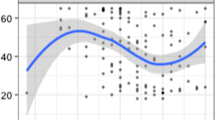Abstract
Purpose
We investigated the relationship between hearing aid or cochlear implants usage and body image, and quality of life.
Methods
Of the 96 participants studied, 26 were cochlear implant users, 20 hearing aid users, 20 non-device users with hearing loss, and 30 normal hearing. The inclusion criteria for the study for all groups were subjects 18 years or older with no other physical complaints. The average age of groups and gender distributions were similar. The Body Image Scale (BIS) and World Health Organization Quality of Life Scale were applied to all participants, whereas the International Outcome Inventory for Hearing Aids, Turkish Version, was applied only to device users.
Results
A significant difference in body image scores was identified between non device users with hearing loss group and normal hearing group, device users group (HA/CI), and cochlear implant users group. In contrast, no significant difference in body image scores between normal hearing group and the device users group was identified. Finally, a positive correlation between body image scores and quality of life scores in all groups was identified.
Conclusions
Non-device users with hearing loss have a lower body image and quality of life than those in the other groups, and device usage has a positive effect on body image and quality of life.
Similar content being viewed by others
References
Adibi SMABM, Chen NR, Azmir NA, Solahan N, Ismail A, Anuar AZ, Ukm M (2013) The quality of life in hearing impaired adolescents after hearing aid application. Med J Malaysia 68(4):315
Akşit AM (1994) Konuşmayı ayırdetme testi için izofonik tek heceli kelime listelerinin oluşturulması. Yüksek Lisans Tezi, Marmara Üniversitesi. Y.Doç.Dr. Nevma Madanoğlu, Danışman
Aslan SH (2001) Beden imgesi ve yeme davranışı bozuklukları ile medya ilişkisi. Düşünen Adam 14(1):41–47
Baker L, Gringart E (2009) Body image and self-esteem in older adulthood. Ageing Soc 29(6):977–995
Becker CB, Verzijl CL, Kilpela LS, Wilfred SA, Stewart T (2019) Body image in adult women: associations with health behaviors, quality of life, and functional impairment. J Health Psychol 24(11):1536–1547
Bektaş DY (2016) Ergenlerde beden imgesi üzerine bir çalışma. Türk Psikolojik Danışma ve Rehberlik Dergisi 3(22)
Cohen SM, Labadie RF, Dietrich MS, Haynes DS (2004) Quality of life in hearing-impaired adults: the role of cochlear implants and hearing aids. Otolaryngol Head Neck Surg 131(4):413–422
Cox R, Hyde M, Gatehouse S, Noble W, Dillon H, Bentler R, Wilkerson D (2000) Optimal outcome measures, research priorities, and international cooperation. Ear Hear 21(4):106S-115S
Davison TE, McCabe MP (2005) Relationships between men’s and women’s body image and their psychological, social, and sexual functioning. Sex Roles 52(7–8):463–475
Eleuteri F, Forghieri M, Ferrari S, Marrara A, Monzani D, Rigatelli M (2010) P01–269-Psychopathological distress, body image perception and social phobia in patients with hearing aids and cochlear implants. Eur Psychiatry 25(S1):1–1
Eser E, Fidaner H, Fidaner C, Eser S, Elbi H, Göker E (1999) WHOQOL-100 ve WHOQOL-BREF’in psikometrik özellikleri. 3P Dergisi 7(ek):23–41
Greene SB (2011) Body image: perceptions, interpretations and attitudes. Nova Science Publishers Inc, New York
Grilo CM, Wilfley DE, Brownell KD, Rodin J (1994) Teasing, body image, and self-esteem in a clinical sample of obese women. Addict Behav 19(4):443–450
Grogan S (2007) Body image: understanding body dissatisfaction in men, women and children. Routledge
Hovardaoğlu S (1993) Vücut Algısı Ölçeği Psikiyatri, Psikoloji, Psikofarmokoloji (3P) dergisi, Testler Özel Eki
Lotfi Y, Mehrkian S, Moossavi A, Faghih-Zadeh S (2009) Quality of life improvement in hearing-impaired elderly people after wearing a hearing aid. Arch Iran Med 12(4):365–370
Lott LM (2016) Evaluation of hearing aid wearers’ appearance by individuals who do not wear hearing aid devices. Thesis. University of Southern Mississippi / Edward Goshorn, Ph.D., Thesis Adviser
Mo B, Lindbæk M, Harris S (2005) Cochlear implants and quality of life: a prospective study. Ear Hear 26(2):186–194
Mond J, Mitchison D, Latner J, Hay P, Owen C, Rodgers B (2013) Quality of life impairment associated with body dissatisfaction in a general population sample of women. BMC Public Health 13(1):920
Mondelli MFCG, de Souza PJS (2012) Quality of life in elderly adults before and after hearing aid fitting. Braz J Otorhinolaryngol 78(3):49–56
Nayir T, Uskun E, Yürekli MV, Devran H, Çelik A, Okyay RA (2016) Does body image affect quality of life?: a population based study. PLoS ONE 11(9):e0163290
Nordvik Ø, Heggdal POL, Brännström J, Vassbotn F, Aarstad AK, Aarstad HJ (2018) Generic quality of life in persons with hearing loss: a systematic literature review. BMC Ear Nose Throat Disord 18(1):1
Oktan V, Şahin M (2010) Examination of the relationship between the body image and self-esteem of female adolescents. J Hum Sci 7(2):543–556
Ouyang Y, Wang K, Zhang T, Peng L, Song G, Luo J (2020) The influence of sports participation on body image, self-efficacy, and self-esteem in college students. Front Psychol 10:3039
Rosenberg M, Schooler C, Schoenbach C, Rosenberg F (1995) Global self-esteem and specific self-esteem: different concepts, different outcomes. Am Sociol Rev
Saatçi Ö, Polat B (2016) Geriatrik Popülasyonda İşitme Kaybının ve İşitme Cihazı Kullanım Memnuniyetinin Yaşam Kalitesine Etkisi. 15–4. http://www.kbb-forum.net/journal/uploads/pdf/pdf_KBB_364.pdf
Sahli S, Belgin E (2006) Comparison of self-esteem level of adolescents with cochlear implant and normal hearing. Int J Pediatr Otorhinolaryngol 70(9):1601–1608
Serbetcioglu B, Mutlu B, Kırkım G, Uzunoglu S (2009) Results of factorial validity and reliability of the international outcome inventory for hearing aids in Turkish. J Int Adv Otol 5(1):80–86
Shukla A, Harper M, Pedersen E, Goman A, Suen JJ, Price C, Reed NS (2020) Hearing loss, loneliness, and social isolation: a systematic review. Otolaryngol Head Neck Surg 162(5):622–633
Theunissen SC, Rieffe C, Netten AP, Briaire JJ, Soede W, Kouwenberg M, Frijns JH (2014) Self-esteem in hearing-impaired children: the influence of communication, education, and audiological characteristics. PLoS ONE 9(4):94521
Thomas C, Thomas P (1990) Body images: development, deviance, and change. Guilford Press
Tomas-Aragones L, Marron SE (2016) Body image and body dysmorphic concerns. Acta Derm.-Venereol. 96(sup. 217)L47–50.
Webster J, Tiggemann M (2003) The relationship between women’s body satisfaction and self-image across the life span: the role of cognitive control. J Genet Psychol 164(2):241–252
Funding
This research did not receive any specific grant from funding agencies in the public, commercial, or not-for-profit sectors.
Author information
Authors and Affiliations
Corresponding author
Additional information
Publisher's Note
Springer Nature remains neutral with regard to jurisdictional claims in published maps and institutional affiliations.
Rights and permissions
About this article
Cite this article
Ozturk, S., Çiprut, A.A. The body image in hearing aid and cochlear implant users in Turkey. Eur Arch Otorhinolaryngol 279, 5199–5206 (2022). https://doi.org/10.1007/s00405-022-07371-1
Received:
Accepted:
Published:
Issue Date:
DOI: https://doi.org/10.1007/s00405-022-07371-1




